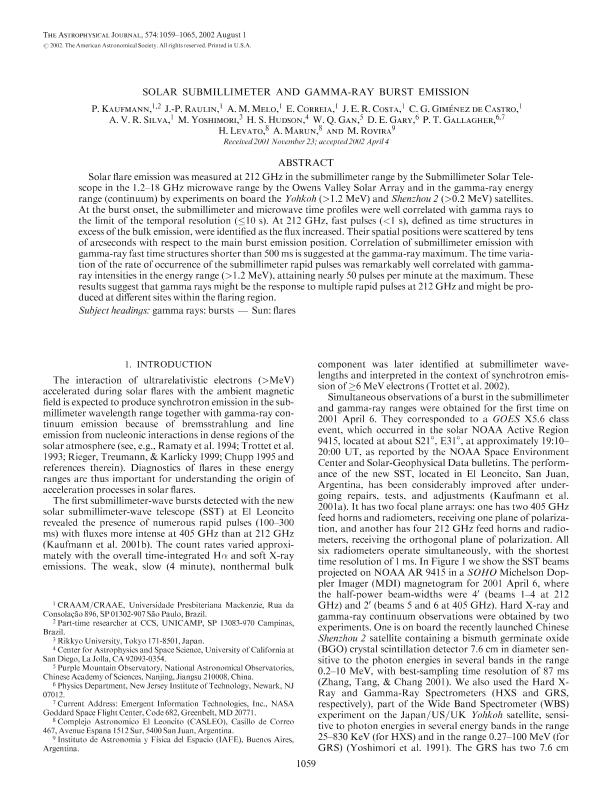Mostrar el registro sencillo del ítem
dc.contributor.author
Kaufmann, Pierre

dc.contributor.author
Raulin, J. P.
dc.contributor.author
Melo, A. M.
dc.contributor.author
Correia, E.
dc.contributor.author
Costa, J. E. R.
dc.contributor.author
Giménez de Castro, C. G.
dc.contributor.author
Silva, A. V. R.
dc.contributor.author
Yoshimori, M.
dc.contributor.author
Hudson, H. S.
dc.contributor.author
Gan, W.Q.
dc.contributor.author
Gary, D. E.
dc.contributor.author
Gallagher, P. T.
dc.contributor.author
Levato, Orlando Hugo

dc.contributor.author
Marun, Adolfo Hector

dc.contributor.author
Rovira, M.
dc.date.available
2023-09-19T12:48:49Z
dc.date.issued
2002-04
dc.identifier.citation
Kaufmann, Pierre; Raulin, J. P.; Melo, A. M.; Correia, E.; Costa, J. E. R.; et al.; Solar submillimeter and gamma-ray burst emission; IOP Publishing; Astrophysical Journal; 574; 2 I; 4-2002; 1059-1065
dc.identifier.issn
0004-637X
dc.identifier.uri
http://hdl.handle.net/11336/211962
dc.description.abstract
Solar flare emission was measured at 212 GHz in the submillimeter range by the Submillimeter Solar Telescope in the 1.2-18 GHz microwave range by the Owens Valley Solar Array and in the gamma-ray energy range (continuum) by experiments on board the Yohkoh (>1.2 MeV) and Shenzhou 2 (>0.2 MeV) satellites. At the burst onset, the submillimeter and microwave time profiles were well correlated with gamma rays to the limit of the temporal resolution (≤10 s). At 212 GHz, fast pulses (<1 s), defined as time structures in excess of the bulk emission, were identified as the flux increased. Their spatial positions were scattered by tens of arcseconds with respect to the main burst emission position. Correlation of submillimeter emission with gamma-ray fast time structures shorter than 500 ms is suggested at the gamma-ray maximum. The time variation of the rate of occurrence of the submillimeter rapid pulses was remarkably well correlated with gamma-ray intensities in the energy range (>1.2 MeV), attaining nearly 50 pulses per minute at the maximum. These results suggest that gamma rays might be the response to multiple rapid pulses at 212 GHz and might be produced at different sites within the flaring region.
dc.format
application/pdf
dc.language.iso
eng
dc.publisher
IOP Publishing

dc.rights
info:eu-repo/semantics/openAccess
dc.rights.uri
https://creativecommons.org/licenses/by-nc-sa/2.5/ar/
dc.subject
GAMMA RAYS: BURSTS
dc.subject
SUN: FLARES
dc.subject.classification
Astronomía

dc.subject.classification
Ciencias Físicas

dc.subject.classification
CIENCIAS NATURALES Y EXACTAS

dc.title
Solar submillimeter and gamma-ray burst emission
dc.type
info:eu-repo/semantics/article
dc.type
info:ar-repo/semantics/artículo
dc.type
info:eu-repo/semantics/publishedVersion
dc.date.updated
2023-07-07T20:30:32Z
dc.journal.volume
574
dc.journal.number
2 I
dc.journal.pagination
1059-1065
dc.journal.pais
Estados Unidos

dc.journal.ciudad
Chicago
dc.description.fil
Fil: Kaufmann, Pierre. Universidade Estadual de Campinas; Brasil. Universidade Presbiteriana Mackenzie; Brasil
dc.description.fil
Fil: Raulin, J. P.. Universidade Presbiteriana Mackenzie; Brasil
dc.description.fil
Fil: Melo, A. M.. Universidade Presbiteriana Mackenzie; Brasil
dc.description.fil
Fil: Correia, E.. Universidade Presbiteriana Mackenzie; Brasil
dc.description.fil
Fil: Costa, J. E. R.. Universidade Presbiteriana Mackenzie; Brasil
dc.description.fil
Fil: Giménez de Castro, C. G.. Universidade Presbiteriana Mackenzie; Brasil
dc.description.fil
Fil: Silva, A. V. R.. Universidade Presbiteriana Mackenzie; Brasil
dc.description.fil
Fil: Yoshimori, M.. Rikkyo University; Japón
dc.description.fil
Fil: Hudson, H. S.. University of California at San Diego; Estados Unidos
dc.description.fil
Fil: Gan, W.Q.. Purple Mountain Observatory Chinese Academy Of Sciences; China
dc.description.fil
Fil: Gary, D. E.. New Jersey Institute of Technology; Estados Unidos
dc.description.fil
Fil: Gallagher, P. T.. New Jersey Institute of Technology; Estados Unidos
dc.description.fil
Fil: Levato, Orlando Hugo. Consejo Nacional de Investigaciones Científicas y Técnicas. Centro Científico Tecnológico Conicet - San Juan. Complejo Astronómico "El Leoncito". Universidad Nacional de Córdoba. Complejo Astronómico "El Leoncito". Universidad Nacional de la Plata. Complejo Astronómico "El Leoncito". Universidad Nacional de San Juan. Complejo Astronómico "El Leoncito"; Argentina
dc.description.fil
Fil: Marun, Adolfo Hector. Consejo Nacional de Investigaciones Científicas y Técnicas. Centro Científico Tecnológico Conicet - San Juan. Complejo Astronómico "El Leoncito". Universidad Nacional de Córdoba. Complejo Astronómico "El Leoncito". Universidad Nacional de la Plata. Complejo Astronómico "El Leoncito". Universidad Nacional de San Juan. Complejo Astronómico "El Leoncito"; Argentina
dc.description.fil
Fil: Rovira, M.. Consejo Nacional de Investigaciones Científicas y Técnicas. Oficina de Coordinación Administrativa Ciudad Universitaria. Instituto de Astronomía y Física del Espacio. - Universidad de Buenos Aires. Facultad de Ciencias Exactas y Naturales. Instituto de Astronomía y Física del Espacio; Argentina
dc.journal.title
Astrophysical Journal

dc.relation.alternativeid
info:eu-repo/semantics/altIdentifier/url/https://iopscience.iop.org/article/10.1086/341061
dc.relation.alternativeid
info:eu-repo/semantics/altIdentifier/doi/http://dx.doi.org/10.1086/341061
Archivos asociados
